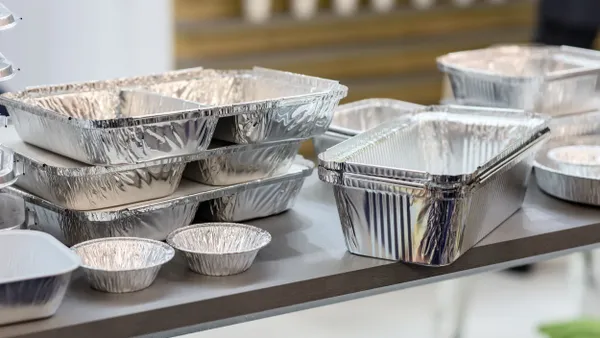The molded fiber packaging sector is on an upswing, largely driven by brands’ desire to transition away from plastic to alternatives they view as more sustainable. While the wet molding process has dominated for decades, dry molding is sparking interest for its potential to further reduce emissions as well as energy and water consumption.
Sweden-based PulPac only has been around for about six years, but already it is known as a leading company in the dry molded fiber space. Previously, most of its technology licensees were based outside of North America, but it’s now gaining traction in the United States. Just last month, Dart Container became the first U.S.-based licensee for PulPac’s new Scala equipment. That adds to PulPac’s relationships with Graphic Packaging International and equipment supplier Curt G. Joa.

PulPac Chief Commercial Officer Sanna Fager spoke at the International Molded Fiber Association’s annual conference last month, describing the dry molded fiber process and how her company estimates it can lower the production of carbon emissions by up to 90% versus the wet process.
Packaging Dive sat down with Fager at the IMFA conference to discuss PulPac’s business, its biggest challenges and where it’s going.
This interview has been edited for length and clarity.
PACKAGING DIVE: PulPac is a young company. As chief commercial officer, do you feel like your role is different at PulPac than it would be at a more established company, or for a more established technology?
SANNA FAGER: They both need to continuously explain the technology, be very close with the new technology and do the continuous technology development that we are doing in my role.
But we also have a new business model. That is something that we need to make sure the industry understands. That’s the key challenge. We are moving fast at PulPac, and we are seeing what we can do with the technology.
Are there other big focus areas for you besides getting out the word about the new technology?
The focus areas are to find the right licensees, the right partners, that would like to engage with this technology. We know that we don’t have all the proofs for running a production line for [many] years. So we need to engage with a converter to see that.
This is something new. It’s an exciting place to step into. Some are ready to do that, and some are not. We know that some people will wait and probably be interested when this is a mature technology. But we, on the PulPac side, need to find the ones that will be at the forefront.
So far, are you getting the most interest from customers who are already in the fiber space, or from those who are in plastics and want to transition to something like this?
I would say it’s 50-50. We have a broad spectrum of interests. It’s both from those who are using molding thermoforming today and would like to see it grow through production capabilities, but also from the plastic industry.
Are you finding that this technology is best suited for small converters, large companies or both?
We see both. But we see a lot of interest from the smaller plastic converters. It makes sense for them to go into dry rather than wet. What they are telling me is that there are so many big players in wet, so it’s hard for a small plastic converter to find their space in that basically mature business. With this, it’s one machine to invest in and then you can do everything from the raw material to the finished product.
Of course, it’s something the larger companies are looking into as well. But they often invest in one machine and will validate that, and when their operation pays for that, they grow from there.
Talk about your strategy for growth in the United States. Is it different from how you approach other regions?
The strategy for growth in the U.S. is that we have established a turnkey partner. Which is great, because we found it to be challenging when we didn’t have a machine partner to recommend in the U.S. With Joa being the established partner, they are the ones selling the machines in the U.S.
The strategy from the product point of view is a little bit different in the U.S., based on the fact that there is not that much legislation, if you compare it to Europe, for example. So the driving forces will always be that the consumer wants change. The behavior of the consumer will always be what someone is looking for — fiber-based lids, for example, instead of plastic. I think that’s going slower in the U.S. compared to other markets that we are active in.
Sustainability is your main selling point when compared to wet molded fiber. But some people have posed sustainability questions about the dry process only using virgin fiber, while wet uses recycled. How does that play into your strategy and carbon footprint discussion?
We are working with soft wood virgin fiber today. We have from lab testing established a lot of different material as well that can be used in the technology. But both of the machine platforms today are based on material ... that fits well with virgin fluff pulp, a source of material that is normally used within this industry. It is a good starting point.
We have seen also that recycled fiber is something that could be challenging from a food contact perspective. A lot of the products that our customers are looking for are in the food service area. And the white products are something they are looking for.
We know that in a cradle-to-grave life cycle assessment we are still much lower compared to what you get from plastic. Of course, we know that a good part of that will be the material that we are using in the process. But also something that we know is [reducing] water consumption in manufacturing the feedstock is something that all the mills are working on.
What do you see ahead for PulPac in 2025?
We are looking for commercial products on the market from our licensees. And to prove this to be a mature technology as much as possible, and then we see growth from there.
We are onboarding more and more licensees. I think that’s the organic growth we are looking for.
You’ve mentioned a couple times the dry molded fiber technology is maturing. To reach maturity, does it just take time? Or is there something else that could happen with the technology to mature it?
It takes time to make sure that we are finding the machine partners, the converters. But also from the industry, it takes [finding alternative] barriers. That will be a challenge for fiber-based products that are going to be mature and accepted on the market. That’s a thing that we need to work within partnerships to find together, the barriers, and I think that will drive the technology forward.
But considering that you do not produce the machines or products, it really wouldn’t be up to PulPac to come up with appropriate barriers, right?
No, exactly. But we like to develop products from PulPac’s side to help our converters and make sure they can go to market as quick as possible. We know that a lot of customers have their own lab and research as well when it comes to finding the right sustainable barrier. It’s basically for us to combine everything to accelerate.
Does the current action against PFAS in packaging play into your thinking at PulPac?
Yes. We have never worked with PFAS. From the beginning, we said we will not include any barrier that we don’t believe in from a sustainability perspective. It’s a good driving force because ... we know the industry is looking for sustainable barrier alternatives.
What else would you like readers to know?
It is important to make partnerships. There are some hurdles that we need to overcome when it comes to fiber-based products to get them accepted in the market and grow that business — and when it comes to barriers, as mentioned. In our view, we can only do all that by collaboration.






















